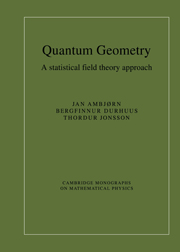7 - Topological quantum field theories
Published online by Cambridge University Press: 20 October 2009
Summary
When quantizing gravity in the functional integral formalism, the metric on the base manifold M is a dynamical variable that is integrated out in the partition function. This was discussed at length in Chapters 4 and 6 in particular cases. Because of general covariance one actually integrates over equivalence classes of metrics related by diffeomorphisms of M, and expectation values of physical observables are therefore diffeomorphism invariants of M. The central problem of quantum gravity in this formalism is to attribute a mathematical meaning to, as well as a physical interpretation of, such expectation values. It is fair to say that substantial results have been obtained in only two dimensions so far.
Introduction
This chapter is devoted to a discussion of certain examples of theories in which general covariance is realized in a simpler way than by averaging over metrics. For example, a theory is generally covariant if its action is a functional of a set of fields on the manifold M which does not involve a metric at all and for which the functional integration measure over the fields is also metric independent. Alternatively, it may occur that although a metric enters the expression defining the action, the energy–momentum tensor nevertheless vanishes on the physical state space. Perhaps the best-known example of the former is the three-dimensional Chern–Simons gauge theory [391]. Examples of the latter are cohomological field theories [393], which include the two-dimensional twisted N = 2 superconformal models [167].
- Type
- Chapter
- Information
- Quantum GeometryA Statistical Field Theory Approach, pp. 297 - 338Publisher: Cambridge University PressPrint publication year: 1997



